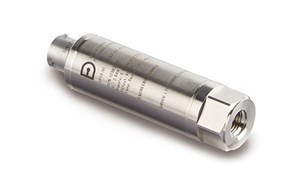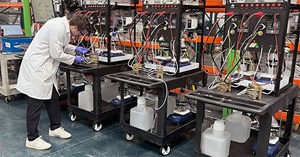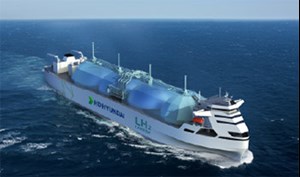Articles
H2Tech: Tech Spotlight
T. CAMPBELL, Managing Editor
H2 EQUIPMENT
Baker Hughes launches new H2 pressure sensor technology
Baker Hughes has launched its latest Druck H2-rated pressure sensors. Designed to offer longer-term stability and withstand harsh environments, the hydrogen (H2) pressure sensors can be used in various applications, including gas turbines, H2 production electrolysis and H2 filling stations.
Long-term exposure to H2 gas degrades the performance of a pressure sensor, specifically through H2 permeation and embrittlement of the isolation diaphragm, meaning the construction of a H2 sensor is key to maintaining accuracy and stability. Baker Hughes’ latest Druck H2 pressure sensors apply high-performance barrier coating technology to protect the sensor element from the harsh effects of H2, providing customers with a market-leading minimum lifespan of 5 yr across a wide range of pressures.
Teledyne Gas & Flame Detection releases an enhanced version of the GS700-Hydrogen
Whether operating with natural gas, pure H2 or H2 blends, the portable GS700-Hydrogen simplifies gas detection across outdoor and indoor leak detection, purging, barholing and pipeline gas testing applications. The fully ATEX-certified instrument enables utilities to determine the source of gas leaks quickly.
The development of the lightweight (1.4 kg) yet durable GS700-Hydrogen was supported by comprehensive field trials aligned with the H2 transition efforts of prominent UK utility companies SGN and Northern Gas Networks. In Scotland, SGN’s H100 Fife project will establish a green H2 gas network in Levenmouth, Fife.
This pipeline, entirely dedicated to 100% H2, will run parallel to the existing natural gas distribution pipeline, providing customers with a choice between the two gases. SGN collaborated with Teledyne Gas Measurement Instruments, a Teledyne GFD brand, to develop the GS700-Hydrogen. This collaborative process ensured the instrument’s suitability for emergency response and engineering teams, enabling them to precisely detect and locate H2 and natural gas leaks. The collaboration resulted in refining the instrument's operation and validating its technology.
Teledyne GMI subsequently partnered with Northern Gas Networks for the UK’s H21 H2 homes project. Northern Gas Networks adopted the GS700-Hydrogen to ensure safety within its H21 networks and measure H2 during activities like purging and pipeline commissioning.
PLIDCO launches new line of H2-compatible fittings
PLIDCO has introduced a new range of products for H2 pipelines in response to the emerging transition toward H2 and other alternative energy sources. PLIDCO’s products are ideal for H2, oil, gas, water, chemical, steam, slurry and other piping systems. The company’s high-pressure fittings are designed and manufactured to meet the highest quality standards, following the American Society of Mechanical Engineers (ASME) and American National Standards Institute (ANSI) codes.
PLIDCO maintains an inventory of fittings compatible with H2 pipelines, allowing customers to stop leaks without shutdown or welding in onshore and subsea environments. Each of its H2-approved products meets U.S. quality standards and has distinctive green markings to differentiate them, helping to ensure mistake-proof repairs.
Bosch releases gas spectrometer to analyze H2
The Bosch optical gas spectrometer (OGS) is an advanced gas analysis system that provides real-time, on-line and in-line gas composition and concentration monitoring. However, its applications are not limited to H2 and natural gas mixtures. The OGS can analyze diverse gas mixtures for their molecular constituents. With the OGS, users can achieve precise control over gas mixtures and processes, improve operational efficiency and reduce gas emissions in various applications. The OGS revolutionizes Raman spectroscopy and will be available in the European market from Q2 2024.
H2 PRODUCTION
H2U completes performance and durability tests for non-iridium catalysts
H2U Technologies has performed durability tests on new, lower-cost, iridium-free catalyst materials that demonstrate a projected lifetime of 25,000 hr. This durability milestone represents a significant breakthrough and addresses supply chain bottlenecks for sustainable H2 production with proton exchange membrane (PEM) electrolyzers.
Discovering non-iridium catalysts for commercial applications has been challenging, as novel materials often degrade rapidly under the harsh acidic conditions of the oxygen evolution reaction (OER). For perspective, the best iridium-free catalysts known to date offer lifetimes of approximately 1,000 hr—1,400 hr. With a baseline of > 4,000 hr of continuous operation thus far, H2U's iridium-free catalysts, tested at 10x higher current density, demonstrate projected lifetimes of > 25,000 hr. H2U catalysts are projected to last at least 6 yr for targeted applications, such as in PEM electrolyzers paired with curtailed renewables.
As the H2 economy grows and the demand for H2 increases, maintaining catalyst performance without relying on iridium becomes even more critical. Durable catalysts enable the scalability of H2 production and utilization technologies by reducing the frequency of replacements and associated costs. The reliance on iridium has raised industry concerns, as the U.S. Department of Energy has recently categorized iridium as the sole material in the H2 sector at high risk of supply disruptions.
H2U's innovative catalysts are cost-effective and more readily available than iridium. Utilizing these affordable alternatives expands the possibilities for electrolyzer stack design, enabling H2U to explore avenues unrestricted by ultra-thin catalyst layers and low usage of catalysts. This flexibility significantly reduces capital expenses, producing more affordable delivered H2.
Technip Energies adds Casale’s ATR technology to deliver large-capacity H2 solutions
Technip Energies has added advanced autothermal reforming (ATR) technology to Blue H2 by T.EN™, its fully-integrated, low-carbon H2 solutions. It is part of Capture.Now, Technip Energies’ strategic platform for carbon capture, utilization and sequestration (CCUS) delivers technology and solutions from a single provider tailored to meet clients’ specific decarbonization and performance needs.
Blue H2 by Technip Energies (T.EN) is a suite of fully integrated, cost-efficient and low-carbon H2 solutions. As a global leader in H2, Technip Energies has recently added oxidative reforming-based technologies in partnership with Casale to its extensive range of proprietary steam methane reforming (SMR) technology solutions.
Casale’s ATR, combined with Technip’s parallel reformer and carbon capture, is a cost-effective way to produce low-carbon H2 at a large scale with optimized steam production. ATR breaks the upper capacity limit of traditional H2 plants, which were economically constrained by the size of the SMR, and enables large-capacity, ultra-blue H2 production with up to a 99% carbon capture rate.
Tailored to meet clients’ specific decarbonization and performance needs, Blue H2 by T.EN comprises the proven building blocks required to create optimal low-carbon H2 solutions and deliver them with increased performance and project certainty. This results in the best possible levelized cost for blue H2 with the lowest carbon footprint regardless of plant feedstock, reforming type or plant capacity.
Rice University researchers discover method to harvest H2 from plastic waste
H2 is viewed as a promising alternative to fossil fuel, but the methods used to produce it either generate too much carbon dioxide (CO2) or are too expensive. Rice University researchers have found a way to harvest H2 from plastic waste using a low-emissions method that could more than pay for itself.
Green H2—produced using renewable energy sources to split water into its two component elements—costs roughly $5 for just over 2 lb. Though cheaper, most of the nearly 100 MMt of H2 used globally in 2022 was derived from fossil fuels, generating roughly 12 t of CO2 per t of H2.
The researchers exposed plastic waste samples to rapid flash Joule heating for about 4 sec, increasing its temperature to 3,100°K. The process vaporizes the H2 present in plastics, leaving behind graphene—an extremely light, durable material made of a single layer of carbon atoms.
HPQ Silicon files patent for autonomous, low-carbon pressurized H2 production system
HPQ Silicon has announced its Lyon-based, affiliated company, Novacium, has filed a patent application for a low-carbon footprint, chemical-based, on-demand and high-pressure autonomous H2 production system.
The new H2 production system uses a chemical process to liberate H2 from specific low-cost, low-carbon footprint and non-hazardous alloys. Furthermore, the H2 produced by the chemical process directly reaches industry-standard pressure levels, typically ranging from 200 bar–1,000 bar.
Unlike traditional electrolysis-based H2 production systems, Novacium's process operates without electricity, extensive storage and complex transportation infrastructure, offering a truly autonomous solution.
The dual-application process, designed for military and civilian uses, addresses a potential client's need for a low-carbon footprint, on-demand, high-pressure autonomous H2 production system deployable anywhere globally, even under off-grid conditions, with safety as a top priority.
Novacium is engaged in discussions to secure grant financing from two potential clients to cover 35%–75% of the costs to deliver the first working prototype of the system by the end of 2024.
Ionomr Innovations validates stability and performance of its anion exchange membrane (AEM) electrolyzer
Ionomr Innovations has completed the Shell GameChanger Accelerator powered by the National Renewable Energy Laboratory (NREL), which provides promising cleantech startups with access to financial resources, state-of-the-art facilities and world-class technical experts. Ionomr has created and is commercializing a new generation of high-performing, environmentally friendly electrochemical materials that are essential building blocks of a green H2 economy.
Working with experts at NREL and Shell and applying industrial and energy agency models, Ionomr has further validated its Aemion+ AEM, providing performance and lifetimes capable of reducing the lifecycle system capital cost of H2 production equipment by water electrolysis by more than 40%. Aemion+ was shown to increase the output of iridium-free electrolysis systems for water electrolysis while repeatedly demonstrating stability from more than 800 hr of tests. It also demonstrated various efficient and stable configurations for directly converting captured CO2 into liquid fuels, improving output three-fold.
Ionomr’s Aemion+ polymers and membranes reduce the cost of green energy because they are designed to eliminate the expensive and scarce components conventionally used for water electrolysis. Materials such as iridium and titanium are replaced with less expensive materials, while performance is enhanced over traditional low-cost alkaline systems and readily pairable with intermittent renewables due to its high ramp rate capability. The membrane technology creates an ultra-stable, lower-cost, safer and more flexible system.
Ionomr’s membranes and polymers are synthesized from an environmentally friendly hydrocarbon base, using a fraction of the energy in their production. They demonstrate no bioaccumulative tendencies and are non-toxic to the environment through production, use and end-of-life. They present the ideal replacements for conventional membrane and polymer products, all containing per- and poly-fluoroalkyl substances.
DuPont introduces ion exchange resin for green H2 production
DuPont has launched its first product dedicated to green H2 production—the DuPont™ AmberLite™ P2X110 Ion Exchange Resin. This newly available ion exchange resin is designed for the unique chemistry of electrolyzer loops to support H2 production.
H2 can be produced by several methods from different feedstocks. Green H2 can play several major roles in the energy transformation, contributing to the decarbonization of transportation, heat and energy, and as greener feedstock. Electrolysis is the process of electrically splitting water molecules into H2 and oxygen gas, and while there are various types of electrolyzers, they all rely on high-purity water as the feedstock to produce H2.
Designed to endure the thermal and chemical challenges presented in an electrolyzer, the AmberLite P2X110 Ion Exchange Resin's recipe offers durable and reliable water quality that helps prevent contaminant build-up in the electrolyzer loop. These customized features and improved removal capacity present a differentiated option for electrolyzers with more service time than industry generic resins.
H2 STORAGE AND TRANSPORTATION APPLICATIONS
DNV awards approval in principle (AiP) to HD KSOE’s H2 system for liquefied H2 carrier
DNV has awarded an AiP to HD Korea Shipbuilding & Offshore Engineering (HD KSOE) and its subsidiaries HD Hyundai Heavy Industry (HD HHI) and Hyundai Mipo Dockyard (HMD) for their new H2 system. HD KSOE aims to complete the development of the H2 carrier technology that enables large-capacity H2 transportation and storage by around 2030.
Sustainably produced zero- and low-carbon H2 has been identified as a key part of the world’s energy transition. Efficient transport by ship faces several challenges, including the complexity of holding H2 at –253°C, some 100°C colder than LNG, at large scale. Finding solutions to this challenge is vital, as shipping has an important role in unlocking the use of H2 in decarbonizing heavy industries (e.g., steel and cement production).
HD KSOE's new system utilizes boil-off gas from H2 transport for a hybrid propulsion system, integrating H2 engines and fuel cells. HD KSOE and partners like Woodside Energy and Linde Engineering are exploring new H2 transportation and storage solutions, aiming to commercialize their advancements by 2030.H2T





